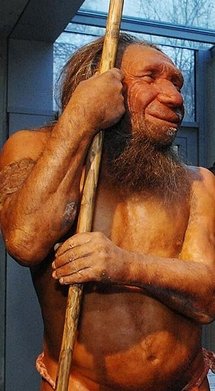
A reconstruction of a Neanderthal at a museum
The research found that as much as four percent of the modern human genome seems to be from Neanderthals.
The study published in the May 7 issue of the journal Science said the Neanderthal DNA was collected from 40,000-year-old bones retrieved from a cave in Croatia.
Neanderthals, our closest evolutionary relatives, appeared some 400,000 years ago and ranged across Europe and western Asia. They became extinct approximately 30,000 years ago.
Researchers said completion of the Neanderthal genome -- hugely important for what it reveals about our ancestral relative -- is perhaps even more significant because of the treasure trove of information that can be gleaned about modern humans.
"For the first time we can now identify genetic features that set us apart from all other organisms, including our closest evolutionary relatives," said the lead researcher on the international study, Svante Paabo of the Max-Planck Institute for Evolutionary Anthropology in Leipzig, Germany.
The researchers identified a catalogue of genetic features that exist in all modern humans, but are not found in Neanderthals or apes.
The squat, low-browed Neanderthals lived in parts of Europe, Central Asia and the Middle East for around 170,000 years but all evidence of them disappears some 28,000 years ago, their last known refuge being Gibraltar.
Why they died out is a matter of furious debate, because they co-existed alongside modern man.
Neanderthals and modern humans shared a common ancestor from which they diverged about 300,000 years ago.
A comparative analysis of the Neanderthal genome shows a variety of genes unique to modern humans.
"With this paper, we are just scratching the surface," said Green.
"The Neanderthal genome is a goldmine of information about recent human evolution, and it will be put to use for years to come."
Scientists said they compared genes involved in cognitive development, skull structure, energy metabolism, and skin morphology and physiology, among others, to determine changes brought about by recent human evolution.
They said it is possible that the interbreeding between Neanderthals and early modern humans occurred in the Middle East, after leaving Africa and before spreading into Eurasia.
The researchers determined, after studying the genomes sequences of five modern humans from around the world -- from China, France, Papua New Guinea, southern Africa and Western Africa -- that the Neanderthal genome sequence proved slightly more similar to those of non-Africans than other groups.
"It's cool to think that some of us have a little Neanderthal DNA in us, Paavo said.
-------------------------------------------------------------------------------
The study published in the May 7 issue of the journal Science said the Neanderthal DNA was collected from 40,000-year-old bones retrieved from a cave in Croatia.
Neanderthals, our closest evolutionary relatives, appeared some 400,000 years ago and ranged across Europe and western Asia. They became extinct approximately 30,000 years ago.
Researchers said completion of the Neanderthal genome -- hugely important for what it reveals about our ancestral relative -- is perhaps even more significant because of the treasure trove of information that can be gleaned about modern humans.
"For the first time we can now identify genetic features that set us apart from all other organisms, including our closest evolutionary relatives," said the lead researcher on the international study, Svante Paabo of the Max-Planck Institute for Evolutionary Anthropology in Leipzig, Germany.
The researchers identified a catalogue of genetic features that exist in all modern humans, but are not found in Neanderthals or apes.
The squat, low-browed Neanderthals lived in parts of Europe, Central Asia and the Middle East for around 170,000 years but all evidence of them disappears some 28,000 years ago, their last known refuge being Gibraltar.
Why they died out is a matter of furious debate, because they co-existed alongside modern man.
Neanderthals and modern humans shared a common ancestor from which they diverged about 300,000 years ago.
A comparative analysis of the Neanderthal genome shows a variety of genes unique to modern humans.
"With this paper, we are just scratching the surface," said Green.
"The Neanderthal genome is a goldmine of information about recent human evolution, and it will be put to use for years to come."
Scientists said they compared genes involved in cognitive development, skull structure, energy metabolism, and skin morphology and physiology, among others, to determine changes brought about by recent human evolution.
They said it is possible that the interbreeding between Neanderthals and early modern humans occurred in the Middle East, after leaving Africa and before spreading into Eurasia.
The researchers determined, after studying the genomes sequences of five modern humans from around the world -- from China, France, Papua New Guinea, southern Africa and Western Africa -- that the Neanderthal genome sequence proved slightly more similar to those of non-Africans than other groups.
"It's cool to think that some of us have a little Neanderthal DNA in us, Paavo said.
-------------------------------------------------------------------------------









 Home
Home Politics
Politics









